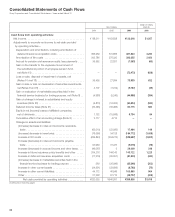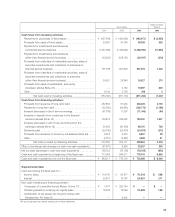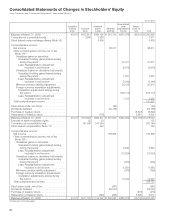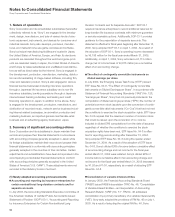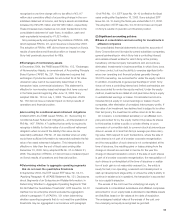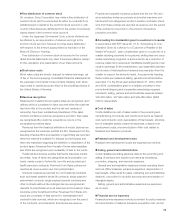Sony 2006 Annual Report Download - page 97
Download and view the complete annual report
Please find page 97 of the 2006 Sony annual report below. You can navigate through the pages in the report by either clicking on the pages listed below, or by using the keyword search tool below to find specific information within the annual report. 95
recognized a one-time charge with no tax effect of ¥2,117
million as a cumulative effect of accounting change in the con-
solidated statement of income, and Sony’s assets and liabilities
increased by ¥95,255 million and ¥97,950 million, respectively.
These increases were treated as non-cash transactions in the
consolidated statement of cash flows. In addition, cash and
cash equivalents increased by ¥1,521 million.
Sony subsequently early adopted the provisions of FIN No. 46R,
which replaced FIN No. 46, upon issuance in December 2003.
The adoption of FIN No. 46R did not have an impact on Sony’s
results of operations and financial position or impact the way
Sony had previously accounted for VIEs.
■Exchanges of nonmonetary assets
In December 2004, the FASB issued FAS No. 153, “Exchanges
of Nonmonetary Assets, an amendment of Accounting Principle
Board Opinion (“APB”) No. 29”. This statement requires that
exchanges of productive assets be accounted for at fair value
unless fair value cannot be reasonably determined or the
transaction lacks commercial substance. This statement is
effective for nonmonetary asset exchanges that have occurred
in the fiscal periods beginning after June 15, 2005. Sony
adopted FAS No. 153 on July 1, 2005. The adoption of FAS
No. 153 did not have a material impact on Sony’s results of
operations and financial position.
■Accounting for conditional asset retirement obligations
In March 2005, the FASB issued FIN No. 47, “Accounting for
Conditional Asset Retirement Obligations—an Interpretation of
FAS No. 143”. FIN No. 47 clarifies that an entity is required to
recognize a liability for the fair value of a conditional retirement
obligation when incurred if the liability’s fair value can be
reasonably estimated. FIN No. 47 also clarifies when an entity
would have sufficient information to reasonably estimate the fair
value of an asset retirement obligation. This interpretation is
effective no later than the end of fiscal years ending after
December 15, 2005. Sony adopted FIN No. 47 on March 31,
2006. The adoption of FIN No. 47 did not have a material impact
on Sony’s results of operations and financial position.
■Determining whether to aggregate operating segments
that do not meet the quantitative thresholds
In September 2004, the EITF issued EITF Issue No. 04-10,
“Applying Paragraph 19 of FASB Statement No. 131, Disclosures
about Segments of an Enterprise and Related Information, in
Determining Whether to Aggregate Operating Segments That
Do Not Meet the Quantitative Thresholds”. EITF Issue No. 04-10
clarifies how an enterprise should evaluate the aggregation
criteria in paragraph 17 of FAS No. 131 when determining
whether operating segments that do not meet the quantitative
thresholds may be aggregated in accordance with paragraph
19 of FAS No. 131. EITF Issue No. 04-10 is effective for fiscal
years ending after September 15, 2005. Sony adopted EITF
Issue No. 04-10 during the fiscal year ended March 31, 2006.
The adoption of EITF Issue No. 04-10 did not have an impact
on Sony’s results of operation and financial position.
(2) Significant accounting policies:
■ Basis of consolidation and accounting for investments in
affiliated companies
The consolidated financial statements include the accounts of
Sony Corporation and its majority-owned subsidiary companies,
general partnerships in which Sony has a controlling interest,
and variable interest entities for which Sony is the primary
beneficiary. All intercompany transactions and accounts are
eliminated. Investments in business entities in which Sony does
not have control, but has the ability to exercise significant influ-
ence over operating and financial policies generally through
20–50% ownership, are accounted for under the equity method.
In addition, investments in general partnerships in which Sony
does not have a controlling interest and limited partnerships are
also accounted for under the equity method. Under the equity
method, investments are stated at cost plus/minus Sony’s equity
in undistributed earnings or losses. Consolidated net income
includes Sony’s equity in current earnings or losses of such
companies, after elimination of unrealized intercompany profits. If
the value of an investment has declined and is judged to be other
than temporary, the investment is written down to its fair value.
On occasion, a consolidated subsidiary or an affiliated com-
pany accounted for by the equity method may issue its shares
to third parties in either a public or private offering or upon
conversion of convertible debt to common stock at amounts per
share in excess of or less than Sony’s average per share carry-
ing value. With respect to such transactions, where the sale of
such shares is not part of a broader corporate reorganization
and the reacquisition of such shares is not contemplated at the
time of issuance, the resulting gains or losses arising from the
change in interest are recorded in income for the year the
change in interest transaction occurs. If the sale of such shares
is part of a broader corporate reorganization, the reacquisition of
such shares is contemplated at the time of issuance or realiza-
tion of such gain is not reasonably assured (i.e., the entity is
newly formed, non-operating, a research and development or
start-up/development stage entity, or where the entity’s ability to
continue in existence is in question), the transaction is accounted
for as a capital transaction.
The excess of the cost over the underlying net equity of
investments in consolidated subsidiaries and affiliated companies
accounted for on an equity basis is allocated to identifiable assets
and liabilities based on fair values at the date of acquisition.
The unassigned residual value of the excess of the cost over
the underlying net equity is recognized as goodwill.





